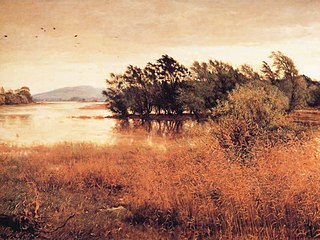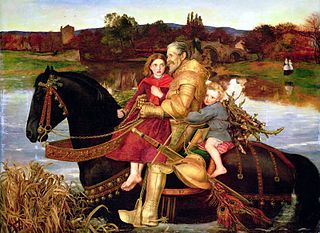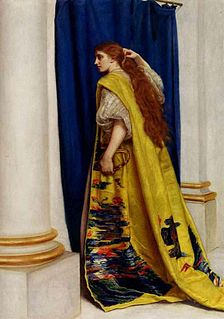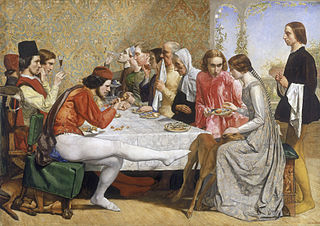 W
WAutumn Leaves (1856) is a painting by John Everett Millais exhibited at the Royal Academy in 1856. It was described by the critic John Ruskin as "the first instance of a perfectly painted twilight." Millais's wife Effie wrote that he had intended to create a picture that was "full of beauty and without a subject".
 W
WThe Black Brunswicker (1860) is a painting by John Everett Millais. It was inspired in part by the exploits of the Black Brunswickers, a German volunteer corps of the Napoleonic Wars, during the Waterloo campaign and in part by the contrasts of black broadcloth and pearl-white satin in a moment of tender conflict.
 W
WThe Blind Girl (1856) is a painting by John Everett Millais which depicts two itinerant beggars, presumed to be sisters, one of whom is a blind musician, her concertina on her lap. They are resting by the roadside after a rainstorm, before travelling to the town of Winchelsea, visible in the background.
 W
WThe Boyhood of Raleigh is a painting by John Everett Millais, which was exhibited at the Royal Academy in 1871. It came to epitomise the culture of heroic imperialism in late Victorian Britain and in British popular culture up to the mid-twentieth century.
 W
WBubbles, originally titled A Child's World, is an 1886 painting by Sir John Everett Millais that became famous when it was used over many generations in advertisements for Pears soap. During Millais's lifetime it led to widespread debate about the relationship between art and advertising.
 W
WChill October is an 1870 oil painting by John Everett Millais which depicts a bleak Scottish landscape in autumn. The painting measures 141.0 cm × 186.7 cm. It was the first large-scale Scottish landscape painted by Millais.
 W
WChrist in the House of His Parents (1849–50) is a painting by John Everett Millais depicting the Holy Family in Saint Joseph's carpentry workshop. The painting was extremely controversial when first exhibited, prompting many negative reviews, most notably one written by Charles Dickens. It catapulted the previously obscure Pre-Raphaelite Brotherhood to notoriety and was a major contributor to the debate about Realism in the arts.
 W
WA Dream of the Past: Sir Isumbras at the Ford (1857) is a painting by John Everett Millais depicting a medieval knight helping two young peasant children over a swollen river. The children are carrying heavy burdens of wood for winter fuel. Though the title refers to the medieval poem Sir Isumbras, the painting does not illustrate a scene from the original text. However Millais's friend, the writer Tom Taylor, wrote verse in a pastiche of the original poem, describing the event depicted. This was included in the original exhibition catalogue.
 W
WEsther (1865) is a painting by John Everett Millais depicting the central character from the Biblical Book of Esther. It is from Millais's Aesthetic phase, when he was influenced by the work of Frederic Leighton and James McNeill Whistler.
 W
WFerdinand Lured by Ariel is an 1850 painting by John Everett Millais which depicts an episode from Act I, Scene II of Shakespeare's c. 1611 play The Tempest. It illustrates Ferdinand's lines "Where should this music be? i' the air or the earth?". He is listening to Ariel singing the lyric "Full fathom five thy father lies". Ariel is tipping Ferdinand's hat from his head, while Ferdinand holds on to its string and strains to hear the song. Ferdinand looks straight at Ariel, but the latter is invisible to him.
 W
WA Huguenot, on St. Bartholomew's Day, Refusing to Shield Himself from Danger by Wearing the Roman Catholic Badge. (1851–52) is the full, exhibited title, of a painting by John Everett Millais, and was produced at the height of his Pre-Raphaelite period. It was accompanied, at the Royal Academy of Arts in London in 1852, with a long quote reading: "When the clock of the Palais de Justice shall sound upon the great bell, at daybreak, then each good Catholic must bind a strip of white linen round his arm, and place a fair white cross in his cap.—The order of the Duke of Guise." This long title is usually abbreviated to A Huguenot or A Huguenot, on St Bartholomew's Day.
 W
WIsabella (1848-1849) is a painting by John Everett Millais, which was his first exhibited work in the Pre-Raphaelite style, completed shortly after the formation of the Pre-Raphaelite Brotherhood in 1848. It was first exhibited at the Royal Academy in 1849, and is now in the collection of the Walker Art Gallery in Liverpool.
 W
WMariana is an 1851 oil-on-panel painting by John Everett Millais. The image depicts the solitary Mariana from William Shakespeare's Measure for Measure, as retold in Tennyson's 1830 poem "Mariana". The painting is regarded as an example of Millais's "precision, attention to detail, and stellar ability as a colorist". It has been held by Tate Britain since 1999.
 W
WThe North-West Passage is an 1874 painting by John Everett Millais. It depicts an elderly sailor sitting at a desk, with his daughter seated in a stool beside him. He stares out at the viewer, while she reads from a log-book. On the desk is a large chart depicting complex passageways between incompletely charted islands.
 W
WOphelia is a painting by British artist Sir John Everett Millais, completed in 1851 and 1852 and in the collection of Tate Britain in London. It depicts Ophelia, a character from William Shakespeare's play Hamlet, singing before she drowns in a river in Denmark.
 W
WThe Order of Release, 1746 is a painting by John Everett Millais exhibited in 1853. It is notable for marking the beginnings of Millais's move away from the highly medievalist Pre-Raphaelitism of his early years. Effie Gray, who later left her husband for the artist, modelled for the principal figure.
 W
WPeace Concluded, 1856 (1856) is a painting by John Everett Millais which depicts a wounded British officer reading The Times newspaper's report of the end of the Crimean War. It was exhibited at the Royal Academy in 1856 to mixed reviews, but was strongly endorsed by the critic John Ruskin who proclaimed that in the future it would be recognised as "among the world's best masterpieces". The central figure in the painting is a portrait of Millais's wife Effie Gray, who had previously been married to Ruskin. It is now in the Minneapolis Institute of Arts.
 W
WThe Proscribed Royalist, 1651 (1852–53) is a painting by John Everett Millais which depicts a young Puritan woman protecting a fleeing Royalist after the Battle of Worcester in 1651, the decisive defeat of Charles II by Oliver Cromwell. The Royalist is hiding in a hollow tree, a reference to a famous incident in which Charles himself hid in a tree to escape from his pursuers. Millais was also influenced by Vincenzo Bellini's opera I Puritani.
 W
WThe Rescue (1855) is a painting by John Everett Millais depicting a fireman rescuing three children from a house fire, with their mother receiving them back into her arms.
 W
WThe Return of the Dove to the Ark is a painting by Sir John Everett Millais, completed in 1851. It is in the Thomas Combe collection at the Ashmolean Museum, Oxford.
 W
WThe Ruling Passion, sometimes called The Ornithologist, is a painting by John Everett Millais which was shown at the Royal Academy Exhibition in 1885.
 W
WJohn Ruskin is a portrait of the leading Victorian art critic John Ruskin (1819–1900). It was painted by the Pre-Raphaelite artist John Everett Millais (1829–1896) during 1853–54. John Ruskin was an early advocate of the Pre-Raphaelite group of artists and part of their success was due to his efforts.
 W
WThe Vale of Rest (1858–1859) is a painting by John Everett Millais.
 W
WVanessa (1868) is a painting by John Everett Millais in Sudley House, Liverpool. It is a fancy portrait depicting Jonathan Swift's close friend and correspondent Esther Vanhomrigh (1688–1723), who was known by that nickname, which Swift himself invented for her.
 W
WVictory O Lord! is an 1871 painting by John Everett Millais depicting Moses, Aaron and Hur during the Battle of Rephidim against the Amalekites. Along with his landscape Chill October it represented a major turning point in Millais career.